#Corporate Regulation
Note
Every single MAGA supporting conservative appointed to the courts should star in my new theater play: "Thick Clots Sit In the Pillory and Are Pelted with Rancid Tomatoes". Admission is free.
Sounds great, but do you know what the really awful thing is? They'd still have the power to do exactly what they are currently doing to the country when it comes to abortion, LGBTQ+ issues, race, guns, voting rights, climate change, corporate regulation, economic inequality, immigration, education, the freedom of speech, expression and religion (or the freedom to not believe), and so on.
So, while the idea of throwing tomatoes sounds like a nice way to blow off some steam and win a minor skirmish, they are winning the war. Because ELECTIONS HAVE CONSEQUENCES and the worst possible person won the wrong election at the scariest possible time. And it resulted in a federal judiciary dominated by very conservative judges who have their jobs as long as they live.
Seeing a free play is always nice, but make no mistake, a lot of us are probably going to be paying for this right-wing federal judiciary for the rest of our lives. I'd rather pay to watch something else.
#ELECTIONS HAVE CONSEQUENCES#Judicial Branch#Federal Judiciary#Supreme Court#U.S. Supreme Court#Law#Constitution#Politics#Elections#Right-wing judges#Federal Judges#Abortion Rights#LGBTQ+#Gun Safety#Voting Rights#Climate Change#Corporate Regulation#Greed#Economic Inequality#Immigration#Freedom of Speech#Religious Freedom#Freeom of expression#Vote#Always Vote#And run for office too
11 notes
·
View notes
Text
Lobbyist Liability: Suing the Middle Man
In my anything but expert understanding to bring a case before a court there has to be some kind of injury. It’s not enough that Bob made you mad; there has to be something that actually hurt you physically or financially or in some demonstrable way.
Yes, this has had some hilarious results over the years as lawyers contorted legal theories into fractals to get an ‘injury’ so they could get…
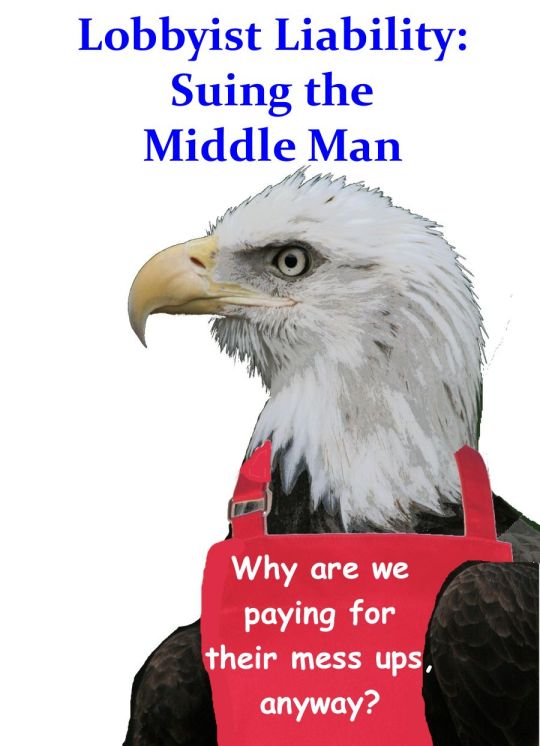
View On WordPress
#congress#corporate regulation#damages#Democrat#Iron Triangle#lawsuits#lobbying.#Lobbyists#party#Politics#Republican
0 notes
Text
“the submarine trip was stupid and rooted in classism”, “it’s absolutely hideous how much more manpower was put into saving and reporting on them vs the 500 migrants who died in a similar horrible fashion”, and “despite their actions, no human being (especially not a nineteen year old) should deserve to die like this, especially when their death will not actually herald any positive change/abolishment of the billionaire class” are three thoughts than can and should coexist. you don’t have to mourn their deaths, but you don’t need to celebrate them, either.
#oceangate#titan#leftism#like 'eat the rich' is all well and good but only when positive change is going to be made#talk and laugh about it all you want#but let's not wish death on people when such death isn't necessary#let's talk about the real issues (the manpower put into rescuing this people vs the migrants)#and the abuse of safety regulations by huge corporations
4K notes
·
View notes
Text

#handgun violence#gun violence#gun control#never trump#republican assholes#traitor trump#crooked donald#2nd amendment assholes#assault weapons ban#well regulated militia = murder in the streets#Mass shooters#school shootings#republican hypocrisy#corporate greed#republican party#Republicans let us die in the streets for profit
407 notes
·
View notes
Text
1,000,000 stranded Southwest passengers deserved better from Pete Buttigieg

The catastrophic failure of Southwest Air over Christmas 2022 was the worst single-airline aviation failure in American history, stranding over 1,000,000 passengers. But while it was exceptional, it was also foreseeable: 2022 saw Southwest and the other carriers rack up record numbers of cancellations, leaving crews and fliers stranded.
It’s not like the carriers can’t afford to improve things. After pulling in $54 billion in covid relief, the airlines are swimming in cash, showering executives with record bonuses and paying titanic dividends to shareholders. Southwest has announced a $428m dividend.
This isn’t a new problem. Trump’s Transportation Secretary Elaine Chao was a paragon of inaction and neglect, refusing even to meet with consumer advocacy groups. This is bad, because under US law, state attorneys general are not allowed to punish misbehaving airlines — that power vests solely and entirely with the Secretary of Transport.
It’s been two years since Biden appointed Pete Buttigieg to be the human race’s most powerful aviation regulator. Buttigieg started his tenure on a promising note, meeting with the same consumer groups that Chao had snubbed, but after that hopeful beginning, things ground to a halt.
As Corporate Crime Reporter details, William McGee of the American Economic Liberties Project was impressed by the Secretary: “He was intelligent, articulate, he had good questions for us, he was taking notes, he seemed concerned.” But 18 months later, McGee describes Buttigieg’s leadership as “lax.”
https://www.corporatecrimereporter.com/news/200/pete-buttigieg-and-the-southwest-airlines-meltdown/
Buttigieg likes to tout a single enforcement action as his signature achievement: fining six airlines and ordering them to issue refunds to US passengers. But only one of those airlines was a US carrier: Frontier, which only accounts for 2% of all US flights. The US monopoly carriers have gone unscathed.
The US carriers are in sore need of regulatory discipline. In 2020 alone, United racked up 10,000 consumer complaints, twice as many as any other carrier. Under Buttigieg, the DOT investigated these airlines and closed every one of these complaints without taking any against them.
This is part of a wider pattern. In Buttigieg’s 18 month tenure, not a single airline has been ordered to pay any fines as a result of cancellations. In the absence of oversight and accountability, the airlines have made a habit out of scheduling flights they know they don’t have the crew to fly (they used public covid funds to buy out senior crew contracts, retiring much of their workforce).
This gives the airlines the flexibility to offer many flights they know they can’t service, and to allocate crew to whichever runs will generate the most profit, stranding US passengers and holding onto their money for months or years before paying refunds — if they ever do.
Consumer groups weren’t alone in sounding the alarm over the deteriorating conditions in the airline sector. In 2022, dozens of state attorneys general — Democrats and Republicans — sent open letters to Buttigieg begging him to use his broad powers as Secretary of Transport to hold the airlines accountable.
What are those powers? Well, the big one is USC40 Section 41712(a), the “unfair and deceptive” authority modeled on Section 5 of the FTC Act. This authority allows the Secretary to act without further Congressional action, to order airlines to end practices that are “unfair and deceptive,” and to extract massive fines from companies that don’t comply.
As McGee told CCR, “the scheduling and canceling of flights is both unfair and deceptive.” In order to force the airlines to end this practice, Buttigieg would have to initiate an investigation into the practice. The American Economic Liberties Project called on Buttigieg to open an investigation months ago. There has not been such an investigation.
Even on refunds, Buttigieg’s much-touted signature achievement, the Secretary has left Americans in the cold. US law requires airlines to give cash refunds to passengers on cancelled flights. But to this day, passengers are sent unfair and deceptive messages by airlines offering them credit for cancellations, and fliers must fight their way through a bureaucratic quagmire to get cash refunds.
McGee and other advocates met with Buttigieg twelve times sking him to address this. When he finally took action, he ignored the domestic airlines — which racked up 5,700% more complaints in his first year on the job than in the previous year — except for tiny, largely irrelevant Frontier. If you are an American whose journey on an American airline was cancelled, there’s a 98% chance that Buttigieg let them off without a single dollar in fines.
McGee isn’t an armchair quarterback. He is an industry veteran, an FAA-licensed aircraft dispatcher: “I canceled flights. I rescheduled flights. I diverted flights. I delayed flights. I did that every day.”
Apologists for Buttigieg claim that he’s doing all he can: “Pete isn’t in charge of airline IT!” But while USC 40 doesn’t mention computer systems or staffing levels directly, it doesn’t have to: the “unfair and deceptive” standard is deliberately broad, to give regulators the powers they need to protect the American people.
In understanding whether the million fliers that Southwest stranded on the way to their Christmas vacations could have expected more from their DOT, it’s worth looking at how other regulators have used similar authority to protect the American people.
Exhibit A here has to be FTC Chair Lina Khan, whose powers under FTCA5 are nearly identical to Buttigieg’s power under 41712(a) (the DOT language was copied nearly verbatim from the FTCA). Two years ago, Khan began an in-depth investigation into the use of nonompete agreements in the US labor market.
https://www.ftc.gov/news-events/events/2020/01/non-competes-workplace-examining-antitrust-consumer-protection-issues
This investigation created an extensive evidentiary record on the ways that workers are harmed by these agreements, and collected empirical observations about whether industries really needed noncompetes to thrive (for example, noncompetes are banned in California, home to the most profitable, most knowledge-intensive businesses in the world, undermining claims that these businesses need noncompetes to survive).
Then, right as Southwest was stranding a million Americans, Khan unveiled a rulemaking to ban noncompetes for every American worker, using her Section 5 powers. Khan’s rule is retroactive, undoing every existing noncompete as well as banning them into the future.
https://pluralistic.net/2023/01/10/the-courage-to-govern/#whos-in-charge
This is what a fully operational battle-station looks like! Khan and Buttigieg are among the most powerful people who have ever lived, with more and farther-reaching regulatory authority, more power to alter the lives of millions of people, than almost anyone who every drew breath.
And yet, when Secretary Buttigieg jawbones about the airlines, it’s all pleading, not threats. As McGee says, “If you have a Secretary of Transportation who does not punish the airlines when they act terribly, then we should not be surprised when they continue to behave terribly.”
State AGs from both parties are desperate for Buttigieg to back legislation that would return their right to punish airlines. So far, he has not voiced his support for this regulation. When the Secretary of Transport won’t act, and when he won’t support the right of other officials to act, the American traveler is truly stranded.
Image:
Tomás Del Coro (modified)
https://www.flickr.com/photos/tomasdelcoro/24575277589
Japanexperterna.se (modified)
https://www.flickr.com/photos/japanexperterna/15251188384/
CC BY-SA 2.0:
https://creativecommons.org/licenses/by-sa/2.0/
—
Tarcil (modified)
https://commons.wikimedia.org/wiki/File:La_Brea_Tar_Pits_Elephant_Statues_1990_right.jpg
CC BY-SA 3.0
https://creativecommons.org/licenses/by-sa/3.0/deed.en
[Image ID: The La Brea tar-pits. A Southwest jet is nose-down in the tar, next to a stranded mastodon. In the foreground are the three wise monkeys, their faces replaced with that of Transportation Secretary Pete Buttigieg.]
#pluralistic#inaction#regulation#swa#southwest air#corporate crime reporter#pete buttigieg#Section 41712(a)
715 notes
·
View notes
Text


Is an RB podium bad for F1?
#how would it not be a ‘genuine’ podium simply because they’re taking parts off Red Bull that is well within the regulations???#I can’t believe they’re going to make me deep throat a corporation on main like that all season long#a backmarker gets some financial backing and decides to exploit some symbiosis within legal boundaries of the sport#and suddenly it’s a problem?#and not to make this about Daniel but would this have gotten this much attention if it would have been any other driver pairings at RB?#daniel ricciardo
124 notes
·
View notes
Text
I need someone to explain the Banana Discourse on Twitter in small words. I might be wrong, but far it looks like an argument between
Western communists deciding the economic reorganization of South America towards "self-sufficiency" by taking away the USAmerican demand for bananas, and
White liberals insisting that South America is better off with the US buying bananas from them because collapsing the industry (somehow) would take away jobs.
Because boycotts totally work, nobody else eats bananas, those are the only two options, and South American people don't have any opinions about their own economy. Pick your imperialist.

Edit: Just found out the discourse is because "we must give up bananas for the good of South American socialism" lady brought up her cocaine habit as evidence that she wasn't moralizing pleasure. On being told that the cocaine trade fuels violent crime by drug cartels across South America, she tweeted:
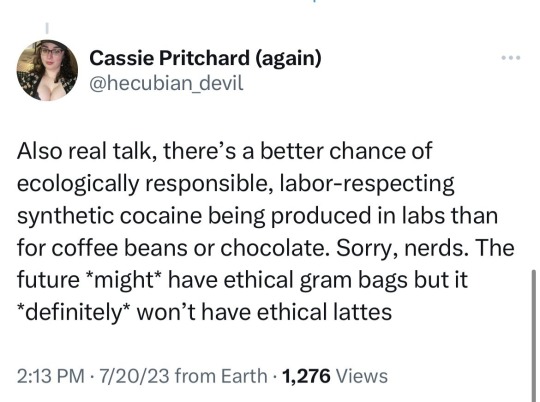
The nightmares of bananas and cocaine production have nothing on the take industry by the hell nexus between white women and Tankies.
#i've deleted all the posts I've reblogged by that Marxist guy#also like...you realize you can talk about multinational corporations human rights violations#and the need for tighter regulations‚ anti-trust laws#and ecological conservation help#without making it all about whether US consumerism is good or bad right?? right???#anti communist#western leftists#tankies#imperialism#colonialism#american exceptionalism#ethnocentrism#twitter discourse#knee of huss
193 notes
·
View notes
Text
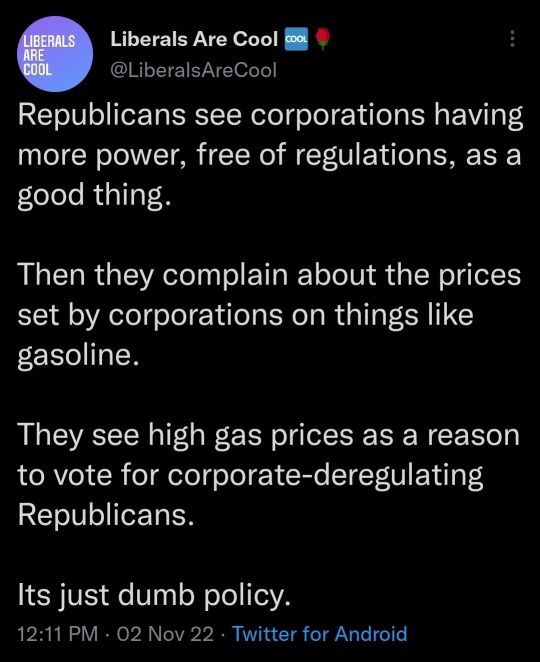
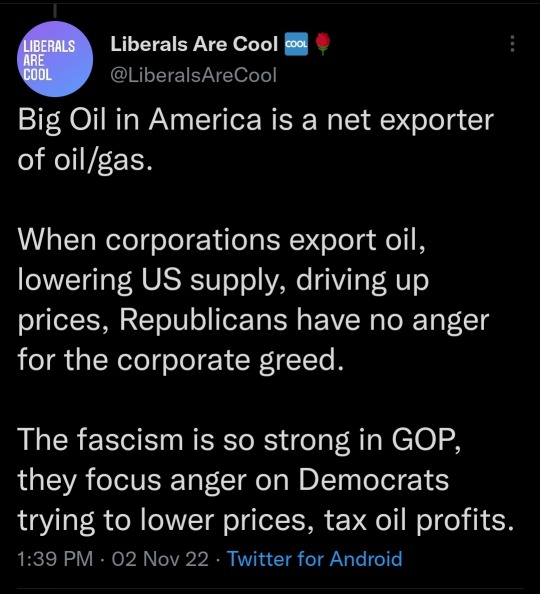
Republicans want to align ideologies with crony corporations. It's called fascism.
Big Oil shows how corporate greed is used by fascists to sway voters.
Right wing media dog whistle gets indoctrinated conservatives to resent the Democratic White House for prices set by Big Oil.
Republican voters can't figure out why gas is expensive, all they are told is 'let's go Brandon' and the conversation is done.
422 notes
·
View notes
Text
RIP Lockwood & Co, you would’ve loved where is the justice from death note the musical
#the rich and famous get away with murder#Lockwood would be screaming that with every bone in his body#afraid to walk the streets at night#need I say more#the corporations make the regulations#Lockwood and co#anthony lockwood#lucy carlyle#george karim
22 notes
·
View notes
Text
“A recent Goldman Sachs study found that generative AI tools could, in fact, impact 300 million full-time jobs worldwide, which could lead to a ‘significant disruption’ in the job market.”
“Insider talked to experts and conducted research to compile a list of jobs that are at highest-risk for replacement by AI.”
Tech jobs (Coders, computer programmers, software engineers, data analysts)
Media jobs (advertising, content creation, technical writing, journalism)
Legal industry jobs (paralegals, legal assistants)
Market research analysts
Teachers
Finance jobs (Financial analysts, personal financial advisors)
Traders (stock markets)
Graphic designers
Accountants
Customer service agents
"’We have to think about these things as productivity enhancing tools, as opposed to complete replacements,’ Anu Madgavkar, a partner at the McKinsey Global Institute, said.”
What will be eliminated from all of these industries is the ENTRY LEVEL JOB. You know, the jobs where newcomers gain valuable real-world experience and build their resumes? The jobs where you’re supposed to get your 1-2 years of experience before moving up to the big leagues (which remain inaccessible to applicants without the necessary experience, which they can no longer get, because so-called “low level” tasks will be completed by AI).
There’s more...
Wendy’s to test AI chatbot that takes your drive-thru order
“Wendy’s is not entirely a pioneer in this arena. Last year, McDonald’s opened a fully automated restaurant in Fort Worth, Texas, and deployed more AI-operated drive-thrus around the country.”
BT to cut 55,000 jobs with up to a fifth replaced by AI
“Chief executive Philip Jansen said ‘generative AI’ tools such as ChatGPT - which can write essays, scripts, poems, and solve computer coding in a human-like way - ‘gives us confidence we can go even further’.”
Why promoting AI is actually hurting accounting
“Accounting firms have bought into the AI hype and slowed their investment in personnel, believing they can rely more on machines and less on people.“
Will AI Replace Software Engineers?
“The truth is that AI is unlikely to replace high-value software engineers who build complex and innovative software. However, it could replace some low-value developers who build simple and repetitive software.”
#fuck AI#regulate AI#AI must be regulated#because corporations can't be trusted#because they are driven by greed#because when they say 'increased productivity' what they actually mean is increased profits - for the execs and shareholders not the workers#because when they say that AI should be used as a tool to support workers - what they really mean is eliminate entry level jobs#WGA strike 2023#i stand with the WGA
75 notes
·
View notes
Text
Small post on my take on AI
Unfortunately, because of how AI has been taken advantage of by large corporations to cut costs, there's a very unhealthy discontent amongst creators and workers with AI.
The fact is that AI will continue to be a part of our lives for the rest of human history, most likely. And that's not a bad thing as it's already in more things than you can imagine, and it's changed how we do things for the better to be completely honest.
With the advancement of AI comes the ability to make people's lives easier. It should be used to help us with/do the boring and mundane tasks so that we can focus on enjoying our time on this earth. However, there definitely needs to be new laws put into place to regulate what AI can and can not be used for.
For example. The shitshow that was Marvel blatantly and openly admitting to using AI art in their trailer for Secret Invasion. I don't care that it's symbolic. It took jobs away from artists just so they could cut corners and not have to pay for it. Just because humans are being replaced in the movie doesn't mean we should do the same irl. Like seriously, learn to separate fiction from reality.
That being said, AI creative works like art and writings should never be used as final products unless they are for personal use only. Rather, they should be used as references and inspiration for creators to expand their horizon or work on new projects. Once again, reference, not final products.
Having said that, yes, AI would have to scoop the internet to continue evolving. The fact of the matter is that AI can't get better without references. However, consent is still important. If a creator doesn't want their stuff put into AI, that's their choice and right. In the same way you can choose not to participate in a study.
In the end, companies need to acknowledge the importance of artists, writers, and workers and their efforts (as well as accept human value in general). Nothing a machine produces will be able to compare to what the hands of a living being can make as they are, in the end, imitations of the original human works.
So again, AI isn't the devil, but it should be monitored and put to use for humans, not against humans.
Corporations need to learn that advancements in technology shouldn't be used to help their profits but to help humanity as whole (which in the end will benefit them if they can just get their heads out of the asses for one minute 🙄). And hopefully with the development of AI and robotics, humans will no longer have to do/work on anything that they don't wish to just so they can survive.
Life should be about enjoyment and experiences, not living paycheck to paycheck, and AI can help with that, but only if it's used properly and not taken advantage of.
#promotion of human happiness through advancements in technology#ai#advancements in technology#advancements in ai#technological advancements#future of technology#future of ai#anti capitalism#anti corporations#anti oligarchy#ai regulation#ai laws
56 notes
·
View notes
Text





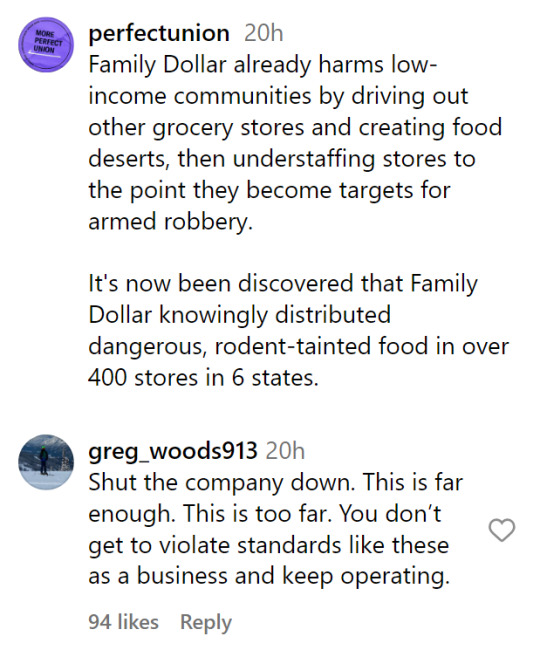
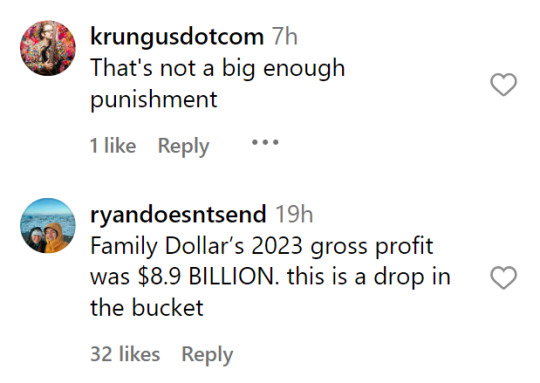
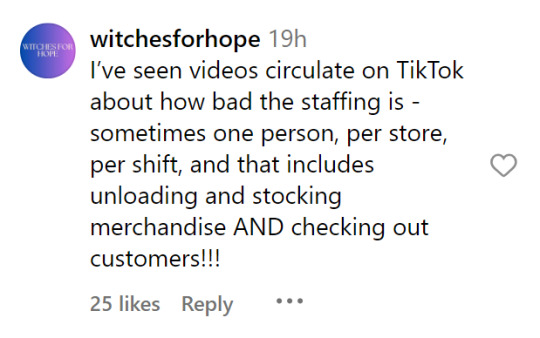
#regulatory enforcement#warehouse conditions#dollar store practices#corporate accountability#public health concerns#food safety regulations#corporate fines#health inspections#family Dollar#family Dollar store
14 notes
·
View notes
Text
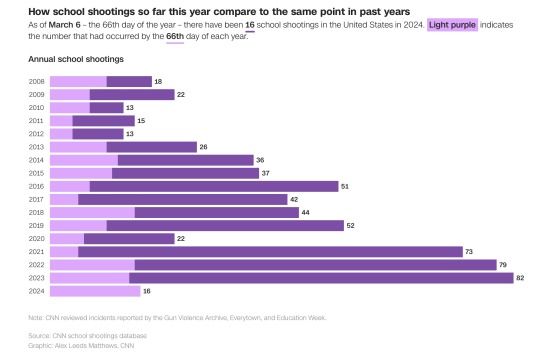
#school shootings#the nra is a terrorist organization#mass shootings#never trump#republican assholes#traitor trump#crooked donald#well regulated militia#gun violence#gun control#gun crime#nra assholes#assault weapons ban#corporate greed
90 notes
·
View notes
Link
Go back to the top of this article and reread that transcript of Rep. Buddy Carter grilling TikTok CEO Shou Zi Chew. Now, Carter is a dunderhead, but he’s dunderheaded in a way that illuminates just how bad COPPA enforcement is, and has been, for 25 long years.
Carter thinks that TikTok is using biometric features to enforce COPPA. He imagines that TikTok is doing some kind of high-tech phrenology to make sure that every user is over 13 (“I find that [you aren’t capturing facial images] hard to believe. It is our understanding that they’re looking at the eyes. How do you determine what age they are then?”).
Chew corrects the Congressdunderhead from Georgia, explaining that TikTok uses “age-gating”: “when you ask the user what age they are.”
That is the industry-wide practice for enforcing COPPA: every user is presented with a tick-box that says “I am over 13.” If they tick that box, the company claims it has satisfied the requirement not to spy on kids.
But if COPPA were meaningfully enforced, companies would simply have to stop spying on everyone, because there are no efficient ways to verify the age of users at the scale needed for general operation of a website.
-How To Make a Child-Safe TikTok: Have you tried not spying on kids?
#privacy#corruption#coppa#Children’s Online Privacy Protection Act#gdpr#general data protection regulation#iab#tiktok#rep buddy carter#Shou Chew#commercial surveillance#ad targeting#ads#ad-tech#cold war 2.0#sinophobia#ireland#eu#european federalism#corporate crime jurisdictions#defund the (corporate) police#age-gating
457 notes
·
View notes
Text
"How much safer has construction really gotten? Let’s take a look.
Construction used to be incredibly dangerous
By the end of the 19th century, what’s sometimes called the second industrial revolution had made US industry incredibly productive. But it had also made working conditions more dangerous...
One source estimates 25,000 total US workplace fatalities in 1908 (Aldrich 1997). Another 1913 estimate gave 23,000 deaths against 38 million workers. Per capita, this is about 61 deaths per 100,000 workers, roughly 17 times the rate of workplace fatalities we have today...
In a world of dangerous work, construction was one of the most dangerous industries of all. By the 1930s and early 1940s the occupational death rate for all US workers had fallen to around 36-37 per 100,000 workers. At the same time [in the 1930s and early 1940s], the death rate in construction was around 150-200 deaths per 100,000 workers, roughly five times as high... By comparison, the death rate of US troops in Afghanistan in 2010 was about 500 per 100,000 troops. By the mid-20th century, the only industry sector more dangerous than construction was mining, which had a death rate roughly 50% higher than construction.
We see something similar if we look at injuries. In 1958 the rate of disabling injuries in construction was 3 times as high as the manufacturing rate, and almost 5 times as high as the overall worker rate.
Increasing safety
Over the course of the 20th century, construction steadily got safer.

Between 1940 and 2023, the occupational death rate in construction declined from 150-200 per 100,000 workers to 13-15 per 100,000 workers, or more than 90%. Source: US Statistical Abstract, FRED
For ironworkers, the death rate went from around 250-300 per 100,000 workers in the late 1940s to 27 per 100,000 today.
Tracking trends in construction injuries is harder, due to data consistency issues. A death is a death, but what sort of injury counts as “severe,” or “disabling,” or is even worth reporting is likely to change over time. [3] But we seem to see a similar trend there. Looking at BLS Occupational Injuries and Illnesses data, between the 1970s and 2020s the injury rate per 100 workers declined from 15 to 2.5.
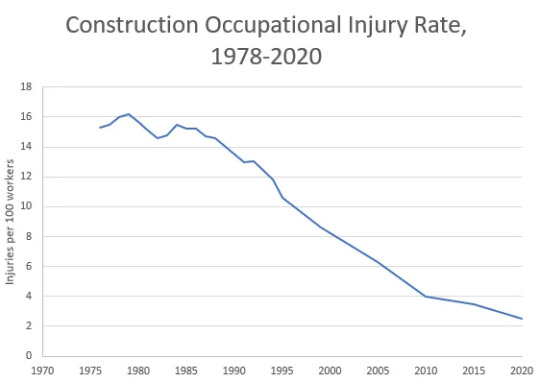
Source of safety improvements
Improvements in US construction safety were due to a multitude of factors, and part of a much broader trend of improving workplace safety that took place over the 20th century.
The most significant early step was the passage of workers compensation laws, which compensated workers in the event of an injury, increasing the costs to employers if workers were injured (Aldrich 1997). Prior to workers comp laws, a worker or his family would have to sue his employer for damages and prove negligence in the event of an injury or death. Wisconsin passed the first state workers comp law in 1911, and by 1921 most states had workers compensation programs.
The subsequent rising costs of worker injuries and deaths caused employers to focus more on workplace safety. According to Mark Aldrich, historian and former OSHA economist, “Companies began to guard machines and power sources while machinery makers developed safer designs. Managers began to look for hidden dangers at work, and to require that workers wear hard hats and safety glasses.” Associations and trade journals for safety engineering, such as the American Society of Safety Professionals, began to appear...
In 1934, the Department of Labor established a Division of Labor Standards, which would later become the Occupational Safety and Health Administration (OSHA), to “promote worker safety and health.” The 1935 National Labor Relations Act (NLRA), which legalized collective bargaining, allowed trade unions to advocate for worker safety.
Following WWII, the scale of government intervention in addressing social problems, including worker safety, dramatically increased.
In addition to OSHA and environmental protection laws, this era also saw the creation of the Consumer Product Safety Commission (CPSC), the National Highway Traffic Safety Administration (NHTSA), and the National Institute for Occupational Safety and Health (NIOSH).
OSHA in particular dramatically changed the landscape of workplace safety, and is sometimes viewed as “the culmination of 60 or more years of effort towards a safe and hazard-free workplace.”"
-via Construction Physics (Substack newsletter by Brian Potter), 3/9/23
#construction#osha#workplace#workplace safety#workers rights#labor rights#occupational health#nlra#collective bargaining#united states#us history#labor unions#industrial revolution#this is why unions and regulations are so fucking important by the way#if you have not studied late 1800s and early 1900s labor history in the US#you really can't grasp how incredibly dangerous things used to be#and how much proof we have that corporations suck#government regulations
89 notes
·
View notes
Text
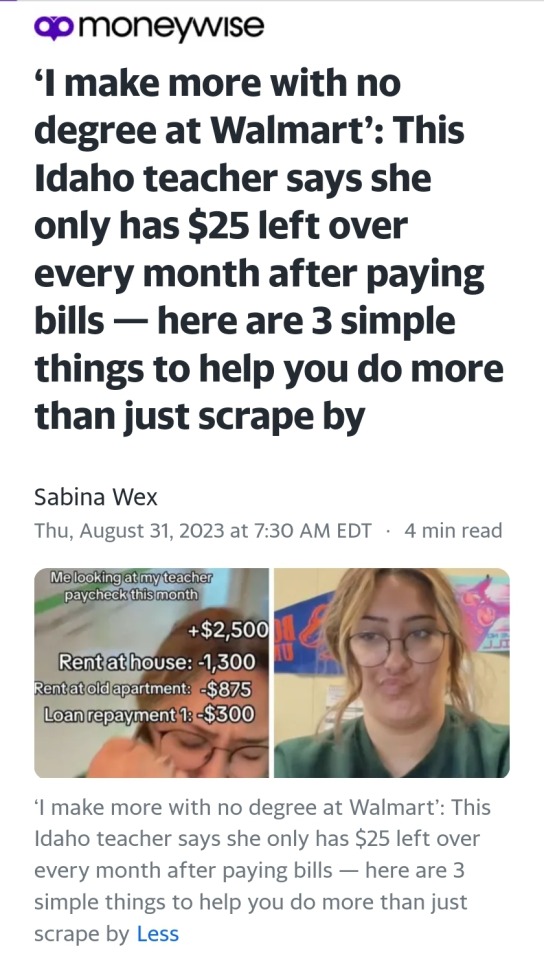
#do the people who write/edit/publish/approve these articles not hear how insanely dystopian this sounds...#capitalism#reminder this is not a free market#in fact the USA is only rated around the 25th least govt regulated market#and isn't it convenient#how it's the ultrawealthy corporate lobbying groups who are able to influence much of what regulations the USA DOES have 🙄#groups like ALEC that are comically evil - like straight up cartoon villains#Cruella de Vil irl type shit#and they just WRITE LAWS that will make them richer at the expensive of all the rest#and essentially legally bribe the actual so-called lawmakers to push their bills through#that isn't democracy... obviously#turns out the invisible hand is just a giant goddamn middle finger. shocking.#capitalism as a theoretical concept relies on the idea that transactions will be entirely or at least predominantly voluntary#and that both parties in the transaction will act out of self interest#but somehow everyone making transactions out of pure self interest and nothing more#ends up working to the benefit of society on the whole#which doesn't really hold water to begin with but gets even more laughable when you take into account that#it falls apart at stage 1 when you realize transactions can't be truly voluntary if#one party is struggling for survival and the other just wants a 7th yacht
38 notes
·
View notes